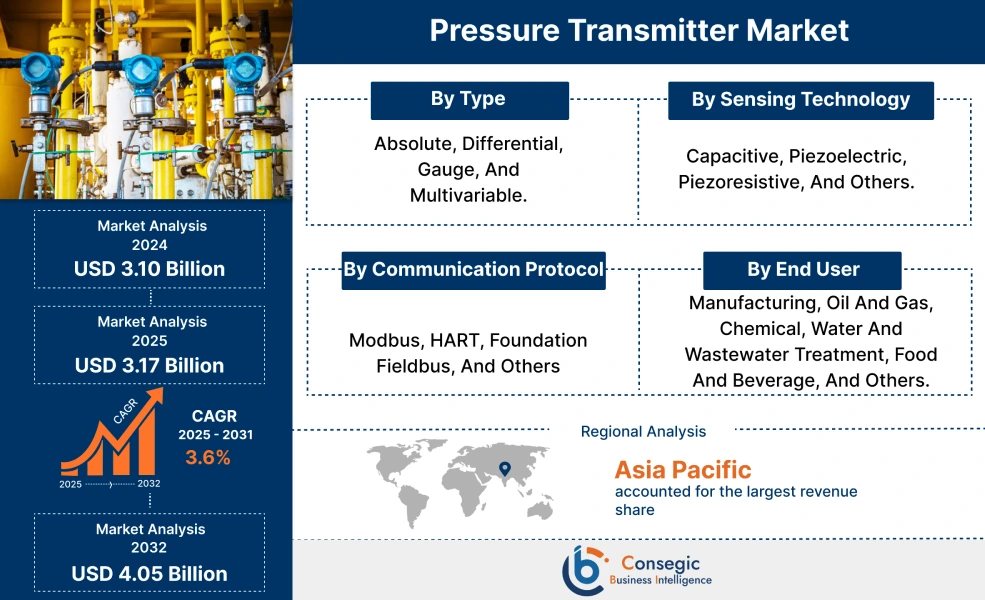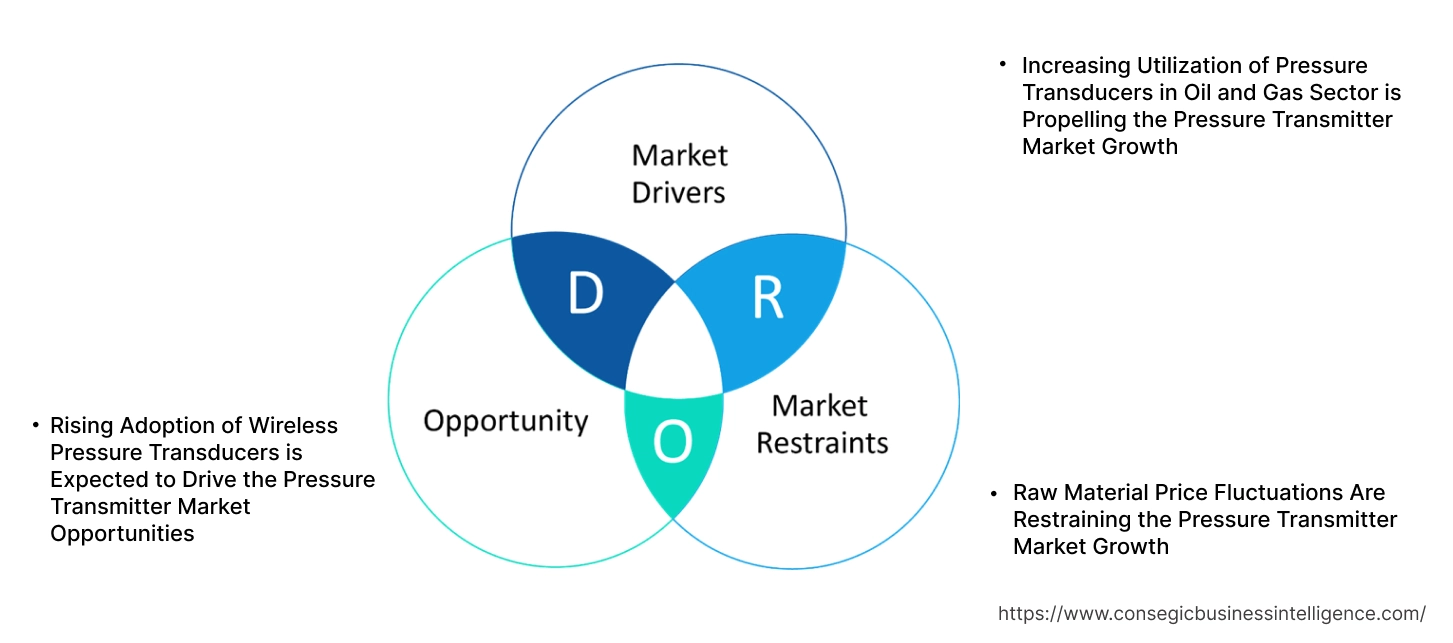Pressure Transmitter Market Size:
Pressure Transmitter Market size is estimated to reach over USD 4.05 Billion by 2032 from a value of USD 3.10 Billion in 2024 and is projected to grow by USD 3.17 Billion in 2025, growing at a CAGR of 3.6% from 2025 to 2032.
Pressure Transmitter Market Scope & Overview:
Pressure transmitter or a pressure transducer refers to a type of device used in industrial settings to detect and respond to changes in pressure. Pressure transducers are typically composed of a pressure sensitive surface area, made of steel and silicon. Moreover, the rising adoption of pressure transmitters in chemical and manufacturing sector to measure the pressure of a liquid in a tank is driving the market. Additionally, the transmitters have witnessed a growing adoption to accurately measure pressure in food and beverage and water and wastewater which has driven the market.
Pressure Transmitter Market Dynamics - (DRO) :
Key Drivers:
Increasing Utilization of Pressure Transducers in Oil and Gas Sector is Propelling the Pressure Transmitter Market Growth
Oil and gas sector utilizes pressure transducers in wellheads to monitor pressure during drilling operations. Further, the transducers are utilized in pipelines to detect leaks and blockages which drive the market. Additionally, rising oil and gas production is driving the overall market as the transducers are utilized to support operations of plunger lift system.
- For instance, according to Invest India, in the year 2023-24, India produced 29.4 million metric tons of crude oil. The rise in crude oil production is expected to boost the market as pressure transducers are utilized to monitor and control pressure in oil and gas.
Hence, the increasing utilization of pressure transducers in oil and gas to monitor pressure during drilling operations is driving the pressure transmitter market size.
Key Restraints:
Raw Material Price Fluctuations Are Restraining the Pressure Transmitter Market Growth
Pressure transducers utilize stainless steel which can be subject to price fluctuations due to growing adoption of steel in various industries including construction and automotive. Further, rising geopolitical tensions may affect the prices of steel as countries impose import restrictions. Moreover, the pressure sensors used in the transmitters utilize silicon which can be subject to supply chain disruptions acting as a restraint to the market growth. Thus, raw material price fluctuations due to fluctuation in prices of steel and silicon devices act as a restraint to the pressure transmitter market expansion.
Future Opportunities :
Rising Adoption of Wireless Pressure Transducers is Expected to Drive the Pressure Transmitter Market Opportunities
Wireless pressure transducers are devices that utilize wireless technology and transmit data about pressure measurements. Additionally, the transducers have witnessed a growing adoption of radio-based communication which is driving the market. Moreover, companies have started utilizing wireless transmitters that feature long life battery designs which is driving the market.
- For instance, Yokogawa offers EJX110B Wireless transmitter that features measurement of liquid, gas, or steam flow. The rise in the adoption of battery-operated transmitters is expected to boost the market.
Thus, the rising adoption of wireless pressure transducers that feature long life battery design is expected to drive the pressure transmitter market opportunities during the forecast period.
Pressure Transmitter Market Segmental Analysis :
By Type:
Based on the type, the market is segmented into absolute, differential, gauge, and multivariable.
Trends in the type:
- Increasing adoption of differential transmitters that feature freely scalable measuring ranges is driving the pressure transmitter market share.
- Rising utilization of warehouse management software for real-time visibility into a company’s inventory is driving the pressure transmitter market trends.
Differential accounted for the largest revenue share of 51.48% in the year 2024
- Differential transmitters measure the difference between two pressures in a system, and are frequently used in closed tank level measurement, which has resulted in the pressure transmitter market expansion.
- Additionally, there has been a rising adoption of differential transmitters for pump and filter monitoring which is driving the global pressure transmitter market.
- Moreover, the increasing utilization of transmitters that feature a stainless-steel casing for better durability is driving the market.
- For instance, Wika offers DPT-20 differential transmitter that features a high measurement accuracy. The rise in the number of differential transmitter offerings for use in process engineering and food and beverage is expected to boost the market.
- According to the market analysis, the rising advancements related to differential due to utilization in closed tank level measurement and pump and filter monitoring is driving the pressure transmitter market trends.
Absolute is anticipated to register the fastest CAGR during the forecast period.
- Absolute pressure transmitters measure the pressure of the process relative to atmospheric air.
- Moreover, the rising utilization of the transmitters in offshore oil and gas projects and laboratory environments of pharmaceutical sector is boosting the market.
- For instance, ABB offers PAS100 absolute transmitter for liquid, gas or steam applications. The rise in adoption of absolute transmitters in oil and gas is expected to boost the market.
- Thus, the increasing adoption of absolute due to utilization in offshore oil and gas is driving the overall market.
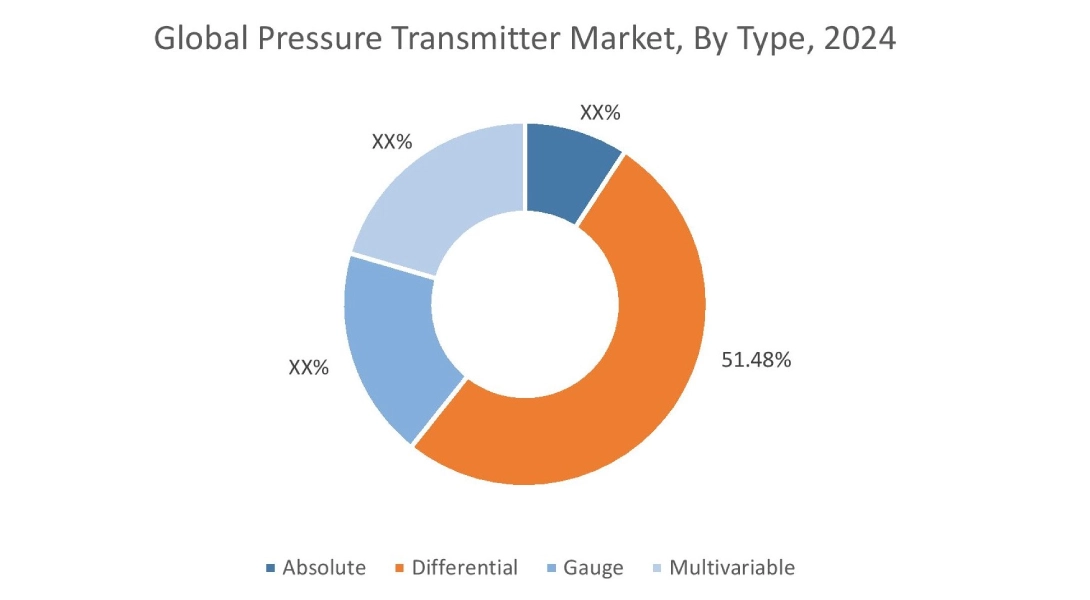
By Sensing Technology:
Based on the sensing technology, the market is segmented into capacitive, piezoelectric, piezoresistive, and others.
Trends in the sensing technology:
- Increasing utilization of piezoresistive due to lower costs and robust construction is driving the market.
- Rising adoption of piezoresistive due to high electrical stability is driving the market.
Piezoresistive accounted for the largest revenue share in the year 2024 and it is anticipated to register the fastest CAGR during the forecast period.
- Piezoresistive pressure sensor utilizes the piezoresistive effect that calculates changes in electrical resistance when a mechanical strain is applied.
- Further, the sensors have experienced a rising adoption due to high accuracy of measurement which is driving the market.
- Moreover, the sensors are being utilized due to good resistance to shock and vibrations which has driven the market.
- Thus, the rising utilization of piezoresistive due to high accuracy of measurement and resistance to shock and vibration is driving the overall market.
By Communication Protocol:
Based on the communication protocol, the market is segmented into modbus, HART, foundation fieldbus, and others.
Trends in the communication protocol:
- Increasing adoption of HART to get transmitter status and diagnostic alerts is driving the market trends.
- There has been a rising utilization of foundation fieldbus due to quick installation and commissioning which is driving the pressure transmitter market demand.
HART accounted for the largest revenue share in the year 2024.
- HART is a communication protocol that is used in industry for transmitting real-time measurement data.
- Further, the rising utilization of HART to provide precise data is driving the pressure transmitter market demand.
- Moreover, HART has experienced a rising adoption in pressure transducers due to simultaneous transmission of both analog and digital signals which is driving the market.
- For instance, Anderson-Negele offers TP Series pressure transducers that feature digital communication via the HART protocol. The rise in the adoption of HART protocol in the transmitters due to access real-time data is driving the market.
- Thus, as per the analysis, the rising adoption of HART to transmit real-time measurement data is driving the market.
Foundation fieldbus is anticipated to register the fastest CAGR during the forecast period.
- Foundation fieldbus has experienced a rising adoption due to reduced system footprint as there are few I/O cards in the system.
- Moreover, the rise in the number of foundation fieldbus offerings in pressure transducers that feature a chemical seal has driven the market.
- For instance, VEGA offers VEGABAR 81 foundation fieldbus transmitter featuring a chemical seal making it suitable for measurements in corrosive environments.
- Therefore, the rising utilization of foundation fieldbus due to reduced system footprint is driving the market.
By End User:
Based on the end user, the market is segmented into manufacturing, oil and gas, chemical, water and wastewater treatment, food and beverage, and others.
Trends in the end user:
- Increasing adoption of pressure transducers in oil and gas to detect leaks is driving the market trends.
- Rising adoption of pressure transmitters in water and wastewater treatment to enhance the quality of wastewater is driving the market growth.
Oil and gas accounted for the largest revenue share in the year 2024.
- Pressure transducers have experienced a rising adoption in oil and gas to monitor pressure in pipelines which has driven the global pressure transmitter market.
- Further, rising utilization of the transmitters in oil and gas to monitor pressure during the hydraulic fracturing process is driving the market demand.
- Moreover, the increasing adoption of transmitters that can withstand high external pressure below sea level is driving the market.
- For instance, ESI offers PR3913 pressure transducer that features hyperbaric testing to 3,300 m depth. The rise in the adoption of transducers that can withstand high external pressure in oil and gas is expected to boost the market.
- Therefore, the increasing demand for pressure transducers in oil and gas to monitor pressure in pipelines and during the hydraulic fracturing process is driving the pressure transmitter market size.
Water and wastewater treatment is anticipated to register the fastest CAGR during the forecast period.
- Pressure transducers have experienced a rising adoption in water and wastewater treatment to record the pressure of an incoming liquid during oil-water separation in sewage treatment which has driven the market.
- Moreover, the rise in the adoption of the transmitters to measure the pressure of the sewage influent is driving the growth of the market.
- Additionally, pressure transducers have experienced a rising adoption for level measurement in wells which has driven the market.
- According to the pressure transmitter market analysis, the rising trend in the adoption of OT systems in semiconductor and electronics to protect against electromagnetic interference and change machine configurations is propelling the pressure transmitter industry during the forecast period.
Regional Analysis:
The regions covered are North America, Europe, Asia Pacific, the Middle East and Africa, and Latin America.
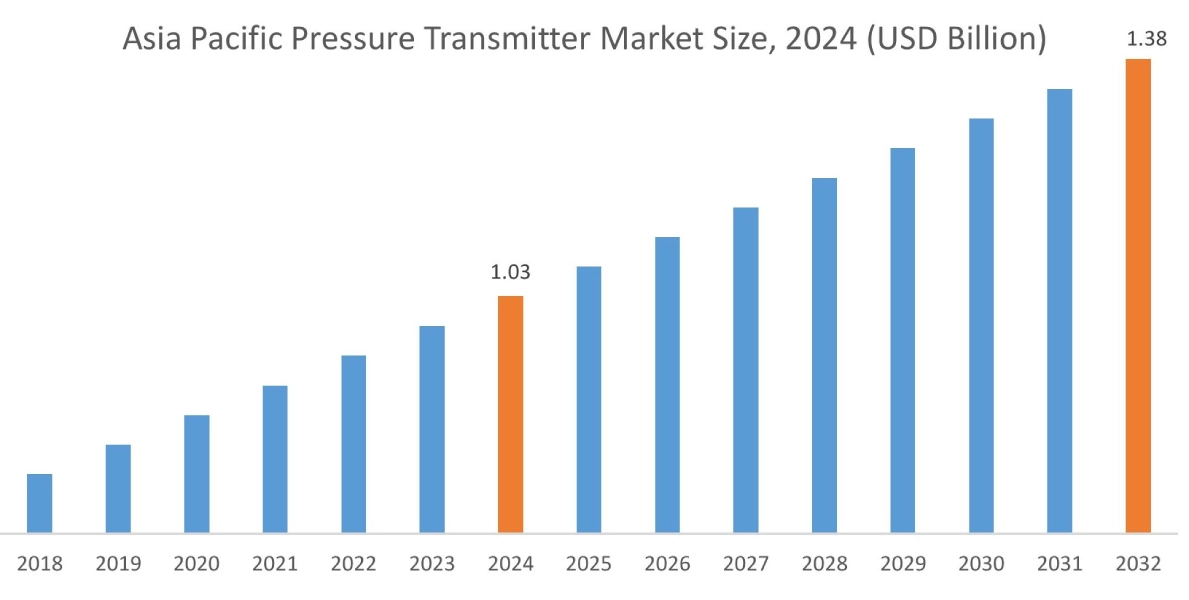
Asia Pacific region was valued at 1.03 Billion in 2024. Moreover, it is projected to grow by 1.06 Billion in 2025 and reach over 1.38 Billion by 2032. Out of this, China accounted for the maximum revenue share of 34.41%. As per the pressure transmitter market analysis, the growth in the Asia-Pacific region is primarily driven by the increasing utilization of differential pressure transducers and rise in the food and beverage sector.
- For instance, according to IBEF, the food processing sector in India has grown at an annual growth rate of around 7.3% from 2015 to 2022. The rise in food processing is expected to boost the market as pressure transducers are used in food and beverage in storage tanks and mixing processes.
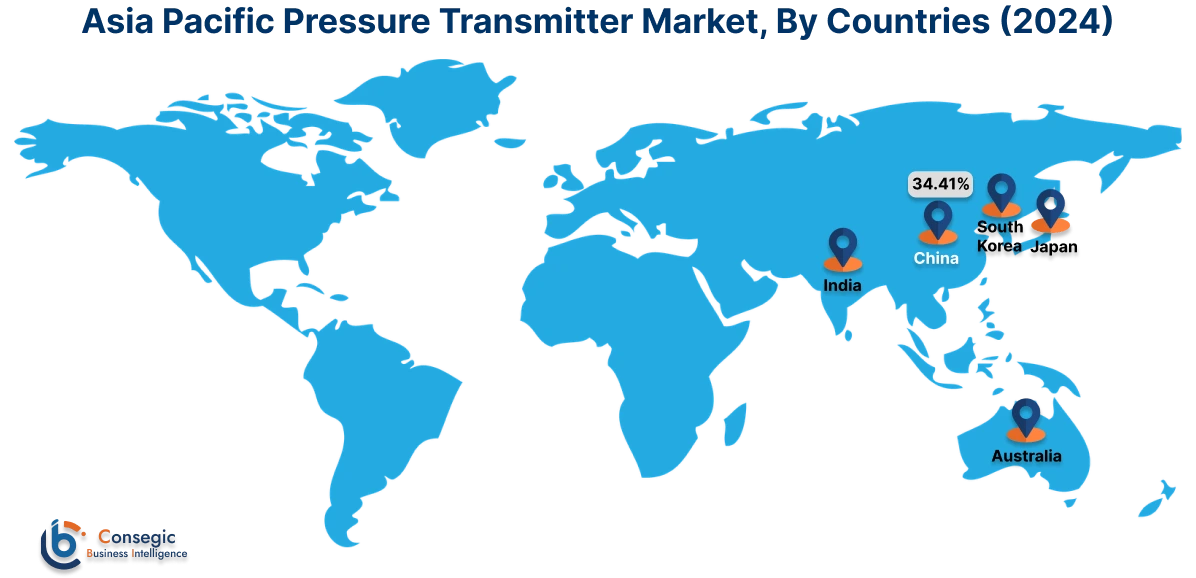
North America is estimated to reach over USD 1.17 Billion by 2032 from a value of USD 0.89 Billion in 2024 and is projected to grow by USD 0.91 Billion in 2025. In North America, the growth of pressure transmitter industry is driven by the increasing adoption of absolute pressure transducers. Moreover, the increasing utilization of the transmitters by water and wastewater treatment facilities has resulted in the rise of pressure transmitter market share.
- For instance, according to S. EPA, wastewater treatment facilities in the U.S. process about 34 billion gallons of wastewater per day. The rising utilization of pressure transducers by wastewater treatment facilities to enhance wastewater quality is expected to boost the market.
Additionally, the regional analysis depicts that the rising investment in the chemical sector is driving the market demand in Europe. Furthermore, as per the market analysis, the market demand in Latin America is expected to grow at a considerable rate due to rising investments utilization of the transmitters in manufacturing. Middle East and African regions are expected to grow at a considerable rate due to factors such as growing investments in the oil and gas sector and rising food and beverage sector among others.
Top Key Players and Market Share Insights:
The global pressure transmitter market is highly competitive with major players providing solutions to the national and international markets. Key players are adopting several strategies in research and development (R&D), product innovation, and end-user launches to hold a strong position in the pressure transmitter market. Key players in the pressure transmitter industry include-
- ABB (Switzerland)
- Fuji Electric (Japan)
- Sino-Inst (China)
- WIKA Alexander Wiegand SE & Co. KG (Germany)
- Emerson Electric Co. (U.S.)
- Omicron Sensing Pvt Ltd. (India)
- Siemens (Germany)
- Honeywell International Inc. (U.S.)
- Yokogawa Electric (Japan)
- Schneider Electric (France)
Recent Industry Developments :
Product Launches:
- In November 2024, ABB unveiled its new pressure measurement devices product portfolio with the aim of optimizing process control. The portfolio consists of P-100, P-300, and P-500 series of pressure measurement devices. The P-500 transmitter integrates digital features including QR codes for advanced operations and Bluetooth for programming.
Pressure Transmitter Market Report Insights :
| Report Attributes | Report Details |
| Study Timeline | 2019-2032 |
| Market Size in 2032 | USD 4.05 Billion |
| CAGR (2025-2032) | 3.6% |
| By Type |
|
| By Sensing Technology |
|
| By Communication Protocol |
|
| By End User |
|
| By Region |
|
| Key Players |
|
| North America | U.S. Canada Mexico |
| Europe | U.K. Germany France Spain Italy Russia Benelux Rest of Europe |
| APAC | China South Korea Japan India Australia ASEAN Rest of Asia-Pacific |
| Middle East and Africa | GCC Turkey South Africa Rest of MEA |
| LATAM | Brazil Argentina Chile Rest of LATAM |
| Report Coverage |
|
Key Questions Answered in the Report
How big is the pressure transmitter market? +
The pressure transmitter market was valued at USD 3.10 Billion in 2024 and is projected to grow to USD 4.05 Billion by 2032.
Which is the fastest-growing region in the pressure transmitter market? +
Asia-Pacific region is experiencing the most rapid growth in the pressure transmitter market.
What specific segmentation details are covered in the pressure transmitter market report? +
The pressure transmitter market report includes type, sensing technology, communication protocol, end user and region.
Who are the major players in the pressure transmitter market? +
The key participants in the pressure transmitter market are ABB (Switzerland), Fuji Electric (Japan), Siemens (Germany), Honeywell International Inc. (U.S.), Yokogawa Electric (Japan), Schneider Electric (France), Sino-Inst (China), WIKA Alexander Wiegand SE & Co. KG (Germany), Emerson Electric Co. (U.S.), Omicron Sensing Pvt Ltd. (India), and Others.
